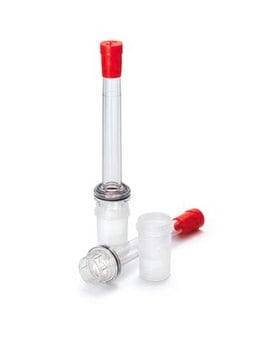MX0486
Methanol
≥99.9% (GC), suitable for LC/MS, OmniSolv®
Synonym(e):
Methylalkohol
About This Item
410 mmHg ( 50 °C)
97.68 mmHg ( 20 °C)
Empfohlene Produkte
Produktbezeichnung
Methanol, OmniSolv® LC-MS, ≥99.9% (GC)
Agentur
suitable for ASTM® 7968
suitable for ASTM® 7979
suitable for DIN 38407-42
suitable for EPA 1613
suitable for EPA 1621
suitable for EPA 1633
suitable for EPA 533
suitable for EPA 537.1
suitable for EPA 8327
suitable for EPA ACB B21-02
suitable for EPA ACB B23-05b
suitable for EPA OTM-45
suitable for GB 31604.35-2016
suitable for GB 5009.253-2016
suitable for ISO 21675 2019
suitable for ISO 25101
suitable for ISO/CEN 15968-2010
Qualitätsniveau
Einhaltung gesetzlicher Vorschriften
suitable for FDA C-010.02
Dampfdichte
1.11 (vs air)
Dampfdruck
128 hPa ( 20 °C)
410 mmHg ( 50 °C)
97.68 mmHg ( 20 °C)
Produktlinie
OmniSolv®
Assay
≥99.9% (GC)
Form
liquid
Selbstzündungstemp.
725 °F
Expl.-Gr.
36 %
Methode(n)
LC/MS: suitable
Verunreinigungen
≤0.05% Water (H2O)
≤0.2 μeq/g Titrable base
≤0.3 μeq/g Titrable acid
≤50 ppb p-nitrophenol (LC/MS)
≤50 ppb reserpine (LC/MS)
Abdampfrückstand
≤1 ppm
Farbe
APHA: ≤10
Brechungsindex
n20/D 1.329 (lit.)
bp
64.7 °C (lit.)
mp (Schmelzpunkt)
−98 °C (lit.)
Übergangstemp.
flash point 9.7 °C
SMILES String
CO
Dichte
0.791 g/mL at 25 °C (lit.)
UV cutoff
≤205 nm
UV-Absorption
λ: 210 nm Amax: ≤0.3
λ: 220 nm Amax: ≤0.1
λ: 230 nm Amax: ≤0.04
λ: 240 nm Amax: ≤0.03
λ: 250 nm Amax: ≤0.01
λ: 270 nm Amax: ≤0.01
λ: 400-280 nm Amax: ≤0.005
Format
neat
Versandbedingung
ambient
Lagertemp.
room temp
InChI
1S/CH4O/c1-2/h2H,1H3
InChIKey
OKKJLVBELUTLKV-UHFFFAOYSA-N
Suchen Sie nach ähnlichen Produkten? Aufrufen Leitfaden zum Produktvergleich
Verwandte Kategorien
Allgemeine Beschreibung
Anwendung
- A solvent to prepare the Mobile phase for LC-MS/MS analysis.
- A solvent or reagent in chemical synthesis
- A solvent in work-up phase of chemical synthesis
- A disinfectant to clean laboratory space.
Angaben zur Herstellung
Hinweis zur Analyse
Rechtliche Hinweise
Sie haben nicht das passende Produkt gefunden?
Probieren Sie unser Produkt-Auswahlhilfe. aus.
Signalwort
Danger
H-Sätze
Gefahreneinstufungen
Acute Tox. 3 Dermal - Acute Tox. 3 Inhalation - Acute Tox. 3 Oral - Flam. Liq. 2 - STOT SE 1
Zielorgane
Eyes,Central nervous system
Lagerklassenschlüssel
3 - Flammable liquids
WGK
WGK 2
Flammpunkt (°F)
49.5 °F - closed cup
Flammpunkt (°C)
9.7 °C - closed cup
Analysenzertifikate (COA)
Suchen Sie nach Analysenzertifikate (COA), indem Sie die Lot-/Chargennummer des Produkts eingeben. Lot- und Chargennummern sind auf dem Produktetikett hinter den Wörtern ‘Lot’ oder ‘Batch’ (Lot oder Charge) zu finden.
Besitzen Sie dieses Produkt bereits?
In der Dokumentenbibliothek finden Sie die Dokumentation zu den Produkten, die Sie kürzlich erworben haben.
Unser Team von Wissenschaftlern verfügt über Erfahrung in allen Forschungsbereichen einschließlich Life Science, Materialwissenschaften, chemischer Synthese, Chromatographie, Analytik und vielen mehr..
Setzen Sie sich mit dem technischen Dienst in Verbindung.







